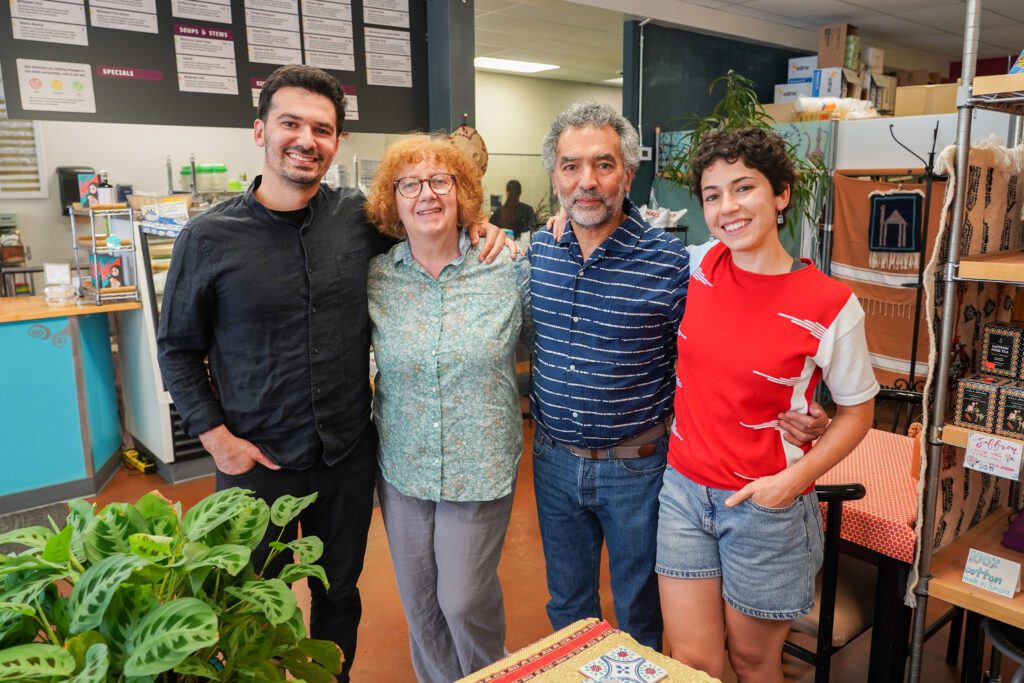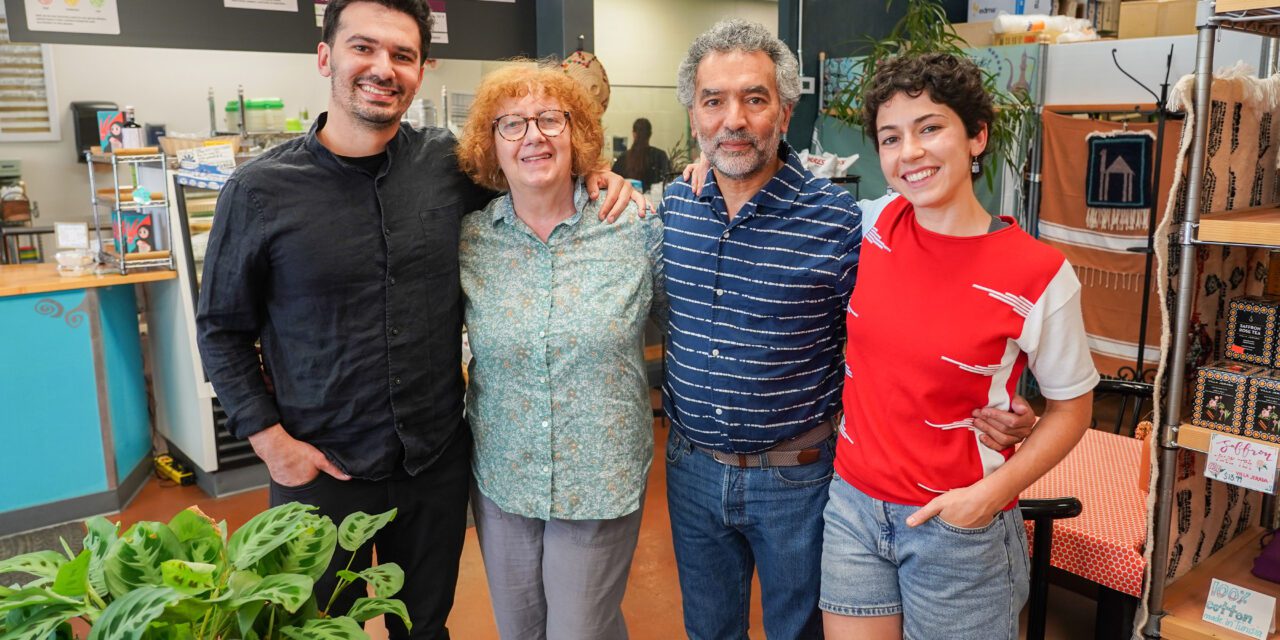Growing up in Toledo a half-century ago, international dining options were limited. Americanized versions of Chinese, Italian, and Mexican fare were what passed for exotic. But time and tourism broadened my palate. Though no globetrotter by nature or budget, I have enjoyed some transcendent travel experiences, and food often offered the most visceral route to expanding cultural appreciation.
I first encountered Indian cuisine at age thirty-two in London, and the complexity of its spice combinations was a revelation. So too was an Indonesian rijsttafel (“rice table”) in Amsterdam. Breakfast in the Place des Vosges, fresh from a patisserie, is a sublime start to a good day of Parisian sightseeing. In an Italian mountain villa, the essence of la dolce vita manifested with the hospitality of a lingering repast highlighted by the freshest of olives and a grandmother’s scratch-made tortellini. And in Poland, I’ll attest, there’s some sort of magic in every soup.
My passport expired during the pandemic, but it’s no hardship that I’m not ready for my next transatlantic red-eye flight. For an inland city of its size, Ann Arbor offers an impressive breadth of restaurant riches from around the world. I credit our nation’s long (though checkered) history of welcoming immigrants, the diversity of global talent that U-M attracts, and the sheer pluck that enables these culinary entrepreneurs to earn a sustainable share of their adopted area’s discretionary dollars.
Over the years, I’ve dined at dozens of worthy eateries representing most of the globe and gleaned cultural insights from their proprietors. With no offense to those omitted—is there ever enough time to visit everywhere on our lists?—what follows is an imaginary itinerary across the continents, all within greater Ann Arbor. Whether in search of the familiar favorites that constitute our own version of soul food, or an adventure into ever-widening horizons, it can be found here, and without the jet lag.

Mexico and Central Ameria have many worthy representatives, but I stamped my imaginary passport at Ramon Martinez and Gladys Ponce’s Borimex Mexican Restaurant, next door to their small grocery at Carpenter and Michigan Ave. | Photo by J. Adrian Wylie
Sojourning southward to start, Frita Batidos has topped the Michigan Daily’s annual list for the best burger in town since 2014. The Cuban-inspired street food concept of renowned chef Eve Aronoff Fernandez centers around the various fritas (burgers) topped with shoestring fries on a soft egg bun, and the tropical batidos (milkshakes). Its white picnic table seating expanded in 2021, along with the addition of a full tropical bar.
Related: Frita Batidos Is Back
Another take on Caribbean fare is Jamaican Jerk Pit, operating from a cozy but colorful space across from Hill Auditorium since 2003. The “jerk” refers not to unsavory slang, but rather to the traditional mixture of spices and cooking methods that produce meats with a characteristic smoky flavor.
Related: Bring on the Heat
Mexican food remains one of America’s favorite international cuisines, from full-
service feasts starting with chips and salsa and lubricated with margaritas, to handy street food so popular that “Taco Tuesday” has evolved from a corporate trademark to an international tradition.
You could spend weeks exploring the range of local Mexican options, from Tios to TMAZ Taqueria. But my first stop is at the fast-casual Borimex Restaurant, which is less known but worthy of wider attention. Gladys Ponce and Ramon Martinez opened it in 2021 next to their small grocery on Carpenter Rd., just south of Michigan Ave.
Related: What’s a Borimex?
Ponce was raised in Puerto Rico, where locals are known as boricuas, explaining the first part of their establishment’s name. Her husband hails from Mexico, and “he’s the one with the recipes,” she says. Rice, beans, and sauces are all prepared in-house—“nothing is canned; everything is fresh,” she notes.
From all-day breakfasts to à la carte tacos to fajita dinners to tortas with avocado and pickled jalepeño, Borimex’s myriad menu options belie its humble strip mall setting. They rely on shredded cheeses and crumbly queso fresco, rather than melted mixtures, along with an extraordinary array of traditional protein preparations—lamb barbacoa, campechano (chorizo and steak), beef ribs, pastor (marinated pork), tongue, tripe, and more. Ponce says they only recently bowed to popular demand by adding ground beef to the menu: “People were like, ‘Why you don’t have it?’ Because we’re authentic, you know?”
So too is Pilar’s Tamales, across town on W. Liberty. Hours and seating are limited, but the spirit of former Salvadoran civil war refugee Sylvia Nolasco-Rivers shines through in the ambiance and her handmade specialties: tamales steamed in corn husks, and pupusas, filled and grilled corn tortillas.
Related: Pilar’s on West Liberty

Lucas and Jamille Chamon missed Brazilain açaí so much that they enlisted their favorite suppliers back home to provide the bases for the bowls and smoothies they’re making at Samba Bowls downtown. | Photo by J. Adrian Wylie
Journeying into the jungles further south, Peruvian fare recently arrived in Ann Arbor at Culantro on N. Main (Marketplace Changes, January). As founder Betty Shuell told me then, the slow-food cuisine derives from traditional Incan produce, including peppers, large-kernel corn, and potatoes, with cross-cultural influence from Asian migration, such as rice and soy sauce. A distinctive drink is the chicha morada, a sort of sweet and tart mocktail imbued with a rich hue from dried purple corn.
Related: The Broken Egg Is Now Culantro
The gastronomy of Brazil is familiar to Americans mainly from all-you-can-eat steakhouses such as the Texas de Brazil chain, which opened an upscale churrascaria at Briarwood Mall last year. But one couple is focusing on the sweeter side, offering a range of açaí bowls and smoothies with bases imported from suppliers back home.
Related: A Trio of Changes at Briarwood
“This is so intrinsic in Brazil: everybody is so used to eating açaí that when you go elsewhere, we want to have it there too, because we can’t understand how people can live without açaí,” says Lucas Chamon, who along with his wife Jamille recently opened Samba Bowls on W. Washington St. (Marketplace Changes, August). The vast majority of the world’s açaí fruit comes from the Amazonian state of Pará, where the earthy palm berries are used not just as a snack or fruit base, but also in sauces for savory dishes, he notes.
Chamon describes the Brazilian food tradition as “very rich,” with great regional diversity resulting from both the abundance of agricultural options and—as in the U.S.—influence from other continents. Their inland home state of Minas Gerais is particularly noted for its cuisine “maybe because we don’t have beaches,” he smiles. “We’re just like, okay, we have to cook well.”
With Samba Bowls, the Chamons aim to expand appreciation for the various fruits that stem from South America, even as bountiful botanical habitats in the Amazon and Atlantic forests are being “pretty much devastated” as a consequence of human development patterns, he says. Chamon is “very sad to see” the government prioritizing progress over the ecosystem. “In the end, I think that some years from now, we’re going to definitely see that it was a bad choice.”
Related: Samba Bowls Takes Vogel’s Spot

El Harissa Market Cafe, 1516 N Maple Rd, Ann Arbor. July 27, 2024. From left to right: Yusef Houamed (son), Susan Thomas and Khaled Houamad (parents), Yasmin Houamed (daughter). | Photo by J. Adrian Wylie
Considering its size, population, and contributions to civilization, Africa is underrepresented in the local restaurant scene. But for thirty-five years, Ann Arborites have kept returning to Blue Nile for its full-service Ethiopian feasts. The vegetarian-friendly fare, rich in legumes, is best shared communally, with the spongy flatbread injera serving as an edible utensil.
Related: Ethiopian Hospitality
The Mediterranean region encompasses parts of three continents, from Spain and Morocco eastward across Italy and Greece to the Levant in western Asia. Its presence among the local dining offerings is similarly expansive, partly from the sizable Arab American population in southeast Michigan. The family-run El Harissa Market Cafe on N. Maple near Miller provides an eclectic entry point to the fresh and flavorful multiplicity of the region. The patriarch and principal chef, Khaled Houamed, hails from Tunisia, “the crossroads of so many different civilizations,” in the words of his daughter Yasmin, who was in town before returning to London to finish graduate studies in the anthropology of food.
Related: El Harissa Opens at Last
An hourlong conversation with the family, including Houamed’s wife Susan Thomas and their other grown child, Yusef, easily doubled my knowledge of Tunisian and Mediterranean history and culture. I knew of the centrality of olive oil but had no concept of garum, a fermented fish sauce highly prized during the time of the Roman Empire. I’m familiar with cumin, caraway, and coriander, but hadn’t realized how southern Mediterranean cooking was enriched by access to those and other spices from Madagascar and the southern parts of the African continent. Ras el hanout (“head of the shop” in Arabic) refers to a secretive blend of spices, as Houamed explains: “Each shop would have its own proportions, and only the head of the shop, the father, would have the recipe.”
He uses it in such dishes as the slow-cooked chicken tagine. Other popular items at El Harissa include the lamb and beef sausage merguez meatballs and the brined, seared, and baked chicken chermoula with a lemony herb sauce. Salads are a mainstay as well, so Khaled does “lots of chopping.” They prioritize a healthful slate of offerings that can be enjoyed every day—but that said, a tempting gelato case includes several exotic palate cleansers.
The diversity, depth, and delicacy of Asian cuisine defies description, at least in a story of this scope. (It’s surely a world away from the Chinese restaurant meals from my youth!) A full fifth of Ann Arbor’s population is of some Asian descent, which of course covers vastly different ethnicities and eating traditions.
Dining options abound—one side of a single block of South U. alone has three Korean eateries—and tastes vary. Family-run Kang’s Korean Restaurant has endured over three decades, and Miss Kim has garnered national acclaim. For Japanese fare, there’s Plate Sushi & Chicken, Totoro, and Yotsuba, among others. Among many representatives from China, Evergreen’s success on Plymouth Rd. led them to add a downtown location in 2022. Excellent Indian options include Shalimar and Cardamom. Pacific Rim by Kana consistently garners good reviews for its Pan-Asian fine dining.
Far be it from me to attempt to single out the best bibimbap, sushi, pad thai, biryani, or bao. Instead, I simply suggest searching for consistency and commitment. A notable example is Ginger Deli, where, owner Te Phan tells me, “It took us almost seven years or eight years to finally turn the corner.” Sustainable success, he says, stems from community recognition that “these guys are sincere in what they want to do and how they want to be a part of this Ann Arbor community.”
Related: Ginger Deli Is Back
The Vietnamese-born Phan is an industrial designer by training, after an undergraduate degree in piano performance. He brings a fondness for conversation and an artistic sensibility to the challenging craft of feeding people, readily expounding on the delicate balance of flavors and textures that make banh mi more like an orchestral composition than a sandwich. It’s a product of Vietnam’s culinary traditions, from the lack of refrigeration and custom of going to market even twice a day for the freshest of vegetables, to the French colonial influence that explains the baguette-like bread and the use of beef in the painstakingly prepared phở, the rice noodle soup some consider the Vietnamese national dish.
The various cuisines of Europe are well-represented by a lengthy slate of long- tenured local establishments. For starters, there’s the Earle for elegant French and Italian fare, Conor O’Neill’s for an Irish pub experience, the old-world Amadeus and its eastern European specialties, Aventura for Spanish tapas and paella, and Italian wining and dining at the likes of Paesano, Palio, or Mani Osteria and Bar.
But none of them have lasted as long as Metzger’s, founded in 1928 by German immigrant baker Wilhelm Metzger and today run by his grandson John, who hopes to pass the baton and head into retirement upon the restaurant’s 100th anniversary. His nephew Ryan Dunkelberger is head chef, continuing to serve up sauerbraten (marinated roast beef with sour cream gravy), schnitzel (breaded pork cutlet), and wurst (sausage) dinners, among their long-standing family recipes.
In its first century, Ann Arbor became home for many German immigrants, but the longevity of Metzger’s was by no means assured. During World War II, rumors circulated around town of secret anti-American meetings above the restaurant (then on E. Washington), impacting the business until the local press helped squelch the falsehoods. In fact, Wilhelm had become a naturalized citizen, and his son Walter, who would later succeed him in the business, served in the U.S. Navy during the war. That history and more hangs among the cuckoo clocks, beer steins, and other decor at Metzger’s current home on N. Zeeb Rd.
As Ann Arbor and nearby communities celebrate their bicentennials, Metzger’s story reminds us that history plays out on stages of all stripes. In an era where ethnic and geographic divisions carry political potency and peril, the universal language of food reminds us that the things we share are essential in their capacity for both celebrating and transcending our differences.
